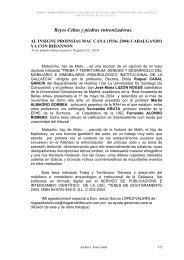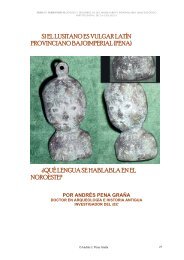EL TEMA DE LA “CAZA SALVAJE” EN LOS ... - riograndedexuvia
EL TEMA DE LA “CAZA SALVAJE” EN LOS ... - riograndedexuvia
EL TEMA DE LA “CAZA SALVAJE” EN LOS ... - riograndedexuvia
Create successful ePaper yourself
Turn your PDF publications into a flip-book with our unique Google optimized e-Paper software.
TREBA Y TERRITORIUM GÉNESIS Y <strong>DE</strong>SARROLLO D<strong>EL</strong> MOBILIARIO E INMOBILIARIO ARQUEOLÓGICO<br />
INSTITUCIONAL <strong>DE</strong> <strong>LA</strong> GAL<strong>LA</strong>ECIA<br />
II CONOCIMI<strong>EN</strong>TO ACUMU<strong>LA</strong>TIVO, METODOLOGÍA Y<br />
OBJETIVOS: <strong>EL</strong> PROMP<strong>TEMA</strong> COMO MÉTODO<br />
1. ANÁLISIS ACUMU<strong>LA</strong>TIVO<br />
En un proceso de larga duración, la adaptación de nuestro método factográfico comparatista 92 a<br />
sistemas arqueológicos 93 nos permite acotar y establecer fehacientes promptemas 94 o series relacionales.<br />
Porque en efecto la cultura material no se puede analizar aislada, obscura per obscuriora, pues las “cosas”que<br />
estudian como elementos no seriados a isocrónicos modelos de comercio y cambio entre el Mediterráneo y lo<br />
Extra-Mediterráneo 95 , siendo la expresión material de sistemas europeos de creencias (J.V.S. MEGAW &<br />
M.Ruth MEGAW 1992: 221ss) 96 no pueden ser concebidas en ingenuas transposiciones apriorísticas como<br />
ansiosos “consumos” efectuados por una sociedad globalizada postindustrial.<br />
Frente a fantásticos planteamientos paralógicos, fuera de un promptema, según lo viera<br />
JACOBSTHAL (1944) y cuarenta años después lo recuerdan Ruth y Vincent MEGAW 97 , la frívola<br />
“cosificación” de la materia arqueológica presente en la taxidermia científica vigente, ahora<br />
deconstructiva, provocando la persistente sonrisa del Gato de Cheshire, parece no tener otros límites<br />
y reglas que las decididas y establecidas por la fantasía del arqueólogo.<br />
92<br />
El método comparatista que proponemos, expuesto a la crítica, pero (basado en el conocimiento<br />
especializado multidisciplinar en Prehistoria, Arqueología, Paleografía, Epigrafía, Latín Clásico y Medieval,<br />
Lingüística y Etnografía Comparada, Historia, Arte y Arqueología Antigua, Medieval y Moderna, Instituciones<br />
Indoeuropeas y Derecho Privado), nos permitirá ocasionalmente expresar en futuro perfecto el registro<br />
arqueológico institucional de la prehistoria y de la protohistoria europea.<br />
93<br />
Esto es, la materia arqueológica cohesionada susceptible de ser estudiada factograficamente en la larga<br />
duración.<br />
94<br />
Recordemos que llamamos serie relacional o promptema al paradigma institucional formado por un grupo<br />
interdependiente de cohesionada materia arqueológica o de sistemas susceptible de ser factográficamente<br />
estudiada: La Caza Salvaje/Menie Hellequin/Herlathingui >Rhiannon> Epona >Bronces Sacrificiales de<br />
Entronización del Noroeste> Diaño Bulreiro>Sociedade do Oso> Santa Compaña>Lares Viales> Caldero de<br />
Gundestrup>) con metodología comparatista interdisciplinar.<br />
95<br />
P. e. la seda china encontrada en los enterramientos hallstáticos de Hohmichelle estudiada por RIEK, G. y<br />
HUNDT, H. J. Der Hohmichelle, Berlin 1962, 206 ss.; cf. HUNDT, H. J. “Die Textillien in Grab von<br />
Hochdof“ in Der Keltenfürst von Hochdorf, herausgegeben von Landesdenkmanmt Baden Würtemberg,<br />
Stuggart, 1985.; WILD, J. P. “Some Early Silk finds in Northwest Europe“, Textile Museum Journal 23 (1984),<br />
p. 17-23. Cf. también WILD, J. P. “Camulodunum and the Silk Road”, Current Arqueology, 93 (1984) p. 298-<br />
9.<br />
96<br />
Cf. ROW<strong>LA</strong>NDS, M. J. refiriendo el contraste entre el Bronce Final y la época de los Oppida de la Edad del<br />
Hierro en terminos económicos: “as a pivotal period in terms of social and economics change because of new<br />
kinds of linkage develop between trade and profit, profit and production”. ROW<strong>LA</strong>NDS, M. J. (forthcoming)<br />
“From the gift to market economies: the ideology and politics of European Iron Age studies”, in Europe in the<br />
1 st Millennium BC, eds. J. Jensen y K. Kristiansen. Sheffield, University of Sheffield Departament of<br />
Archaeology and Prehistory) correspondientes a una sociedad globalizada postindustrial cuando los Oppida<br />
responden y son la expresión material de sistemas europeos de creencias (Cf. J.V.S. MEGAW y M. Ruth<br />
MEGAW 1992, 221 y ss.)<br />
97<br />
J.V.S. MEGAW y M. Ruth MEGAW 1993 “Cheshire Cats, Mickey Mice, the New Europe and Ancient<br />
Celtic Art” in Trade and Exchange in Prehistory Europe, proceedings of a Conference held at the University<br />
of Bristol, April 1992. ED. Chris Scarre and Frances Healy, Oxbow Monograph 33, pp. 219, 232.<br />
Andrés J. Pena Graña 47





